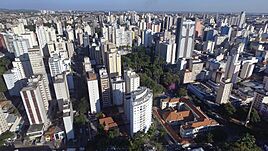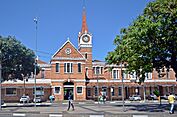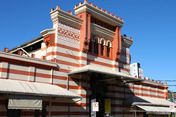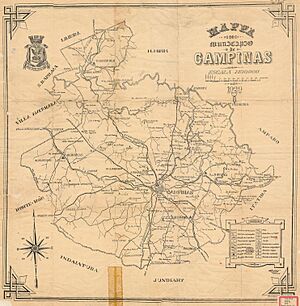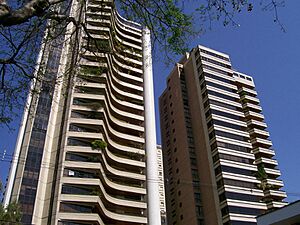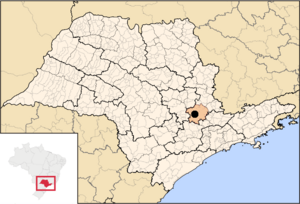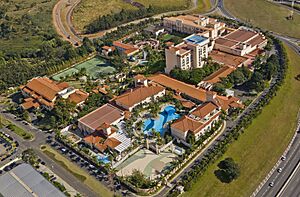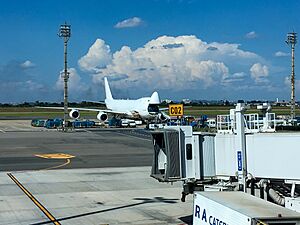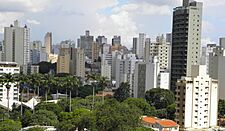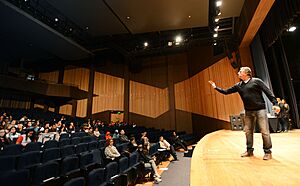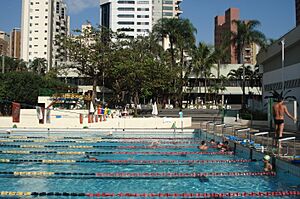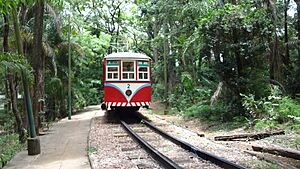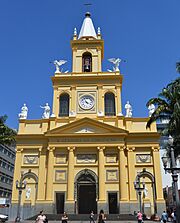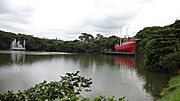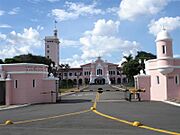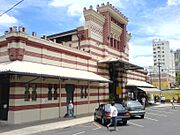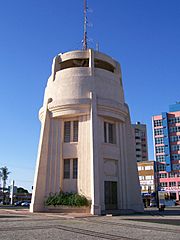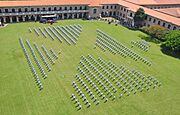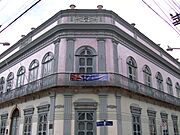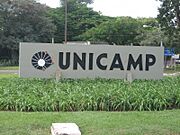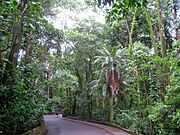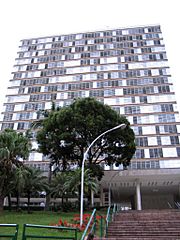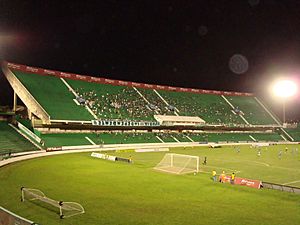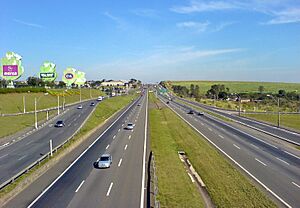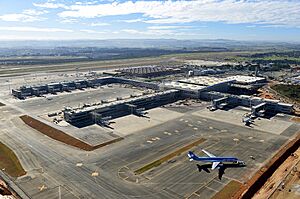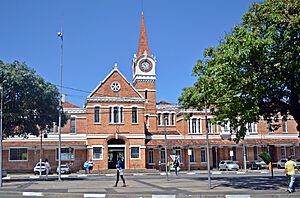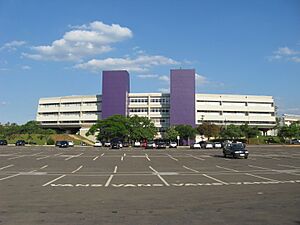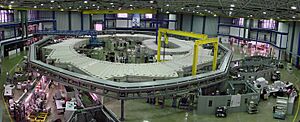Campinas facts for kids
Quick facts for kids
Campinas
|
|||
|---|---|---|---|
|
Municipality
|
|||
| Municipality of Campinas | |||
|
From top left to right: city center panorama; Metropolitan Cathedral of Campinas; Culture Station; Castro Mendes Theater; Castle Tower; Jequitibás Palace; and Prefecture Ex Municipal Market.
|
|||
|
|||
| Nicknames:
Cidade das Andorinhas, Brazilian Silicon Valley, Princesa d'Oeste
|
|||
| Motto(s):
Labore Virtute Civitas Floret (Latin)
At work and virtue, the city flourishes |
|||
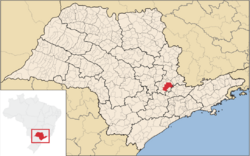
Location of Campinas
|
|||
| Country | |||
| Region | Southeast | ||
| State | São Paulo | ||
| Metropolitan Region | Campinas | ||
| Founded | 14 July 1774 | ||
| Area | |||
| • Municipality | 795.667 km2 (307.209 sq mi) | ||
| • Metro | 3,645 km2 (1,407 sq mi) | ||
| Elevation | 555-780 m (1,821–2,559 ft) | ||
| Population
(2022)
|
|||
| • Municipality | 1,139,047 (14th) | ||
| • Density | 1,433/km2 (553.49/sq mi) | ||
| • Metro | 3,656,363 | ||
| • Metro density | 1,003/km2 (2,600/sq mi) | ||
| GDP (PPP, constant 2015 values) | |||
| • Year | 2023 | ||
| • Total | $66.1 billion | ||
| • Per capita | $29,300 | ||
| Time zone | UTC-3 (Brasilia Official Time) | ||
| Postal Code |
13000-000
|
||
| Area code(s) | +55 19 | ||
| HDI (2010) | 0.805 – very high | ||
Campinas (pronounced kam-PEE-nas) is a big city in São Paulo State, Brazil. Its name means Plains or Meadows. It's part of Brazil's Southeast Region. In 2020, about 1.1 million people lived there. This makes it one of the largest cities in Brazil. Campinas is also the third most populated city in São Paulo state. The larger area around Campinas, called the Metropolitan Region of Campinas, includes twenty nearby towns and has over 3.6 million people.
Contents
- What Does Campinas Mean?
- History of Campinas
- Geography and Nature
- People of Campinas
- Economy of Campinas
- Culture in Campinas
- Fun Things to Do in Campinas
- Seven Wonders of Campinas
- Sports in Campinas
- City Services
- Education in Campinas
- Media in Campinas
- Famous People from Campinas
- Sister Cities
- Images for kids
- See also
What Does Campinas Mean?
The name Campinas means grass fields in Portuguese. This describes the area's original look. It used to have thick forests along rivers, mixed with gentle hills covered in low grass.
The city's official flag and crest show a mythical bird called the phoenix. This is because Campinas almost disappeared after a very serious illness in the 1800s. Many people got sick, but the city managed to recover and grow strong again, just like the phoenix rising from ashes.
History of Campinas

Campinas was founded on July 14, 1774, by Barreto Leme. At first, it was just a small stop for travelers. These travelers, called "Bandeirantes", were exploring Brazil. They were looking for valuable minerals and sometimes for Indigenous slaves.
In the early 1800s, Campinas started to grow. Many farms for coffee, cotton, and sugarcane appeared. A big step for the city was when a railway was built in 1867. This railway connected Campinas to the city of São Paulo and the seaport of Santos.
Later in the 1800s, slavery ended in Brazil. This led to many immigrants coming to Campinas, especially from Italy. They came to work on farms and in new factories. Coffee became a very important product that Campinas exported, making the city rich.
Because of this wealth, Campinas developed many services. By the early 1900s, it had an opera house, theaters, banks, and even radio stations. It also had good schools and hospitals. The Instituto Agronômico de Campinas, a major research center for farming, was founded here by Emperor Pedro II. In 1938, the first Brazilian highway, the Anhanguera Highway, connected Campinas to São Paulo. This helped Campinas grow even more.
Famous people from Campinas include Carlos Gomes (an opera composer) and Campos Salles (a former President of Brazil). Also, Hércules Florence, who helped invent photography, lived here for many years.
Geography and Nature
Campinas covers an area of about 795 square kilometers (307 square miles). About 238 square kilometers (92 square miles) is the city area itself. It is located about 96 kilometers (60 miles) northwest of São Paulo. Neighboring cities include Paulínia, Jaguariúna, and Valinhos.
Nature and Environment
Most of the original plants and trees in Campinas have been removed over time. The city faces some environmental challenges, like flooding and silting (when rivers fill with mud). Today, less than 5% of the city's total area is covered by its original plants.
To help fix this, many projects are underway. One important natural area is the Mata de Santa Genebra. It's about 251 acres (1 square kilometer) and is the second-largest urban forest in Brazil. Only the Tijuca Forest in Rio de Janeiro is bigger.
Campinas also has smaller green spaces like the Bosque dos Jequitibas (Jequitibás Grove), which opened in 1881. Other parks include Parque Portugal (also known as Taquaral Lagoon) and the "Dom Bosco" Ecological Park.
Climate

Campinas has a tropical savanna climate. This means winters are usually dry and mild, not too cold. Summers are rainy and warm to hot. February is the warmest month, with an average temperature of 24°C (75°F). July is the coldest, with an average of 17.8°C (64°F).
The city gets about 1424.5 mm (56 inches) of rain each year. August is the driest month, and January is the rainiest. In recent years, hot, dry days have become more common in winter. This can lead to fires in hills and bushes, especially in rural areas. These fires cause deforestation and release pollution into the air.
The lowest temperature ever recorded was -1.5°C (29.3°F) in June 1918. The highest was 39.0°C (102.2°F) in November 1985. Frost (when the ground freezes) has happened 41 times between 1890 and 2004. The most recent was in July 2000. Sometimes, strong winds with gusts over 100 km/h (62 mph) also occur.
The rainy season is from mid-October to mid-April. The dry season is from mid-May to mid-September. The average humidity changes from 37% in August to 56% in January.
| Climate data for Campinas, elevation 667 m (2,188 ft), (1993–2020 normals, extremes 1890–2012) | |||||||||||||
|---|---|---|---|---|---|---|---|---|---|---|---|---|---|
| Month | Jan | Feb | Mar | Apr | May | Jun | Jul | Aug | Sep | Oct | Nov | Dec | Year |
| Record high °C (°F) | 36.1 (97.0) |
35.8 (96.4) |
34.5 (94.1) |
33.6 (92.5) |
32.4 (90.3) |
30.0 (86.0) |
31.2 (88.2) |
35.0 (95.0) |
37.8 (100.0) |
37.8 (100.0) |
37.8 (100.0) |
36.8 (98.2) |
37.8 (100.0) |
| Mean daily maximum °C (°F) | 29.5 (85.1) |
29.9 (85.8) |
29.5 (85.1) |
28.3 (82.9) |
25.3 (77.5) |
24.7 (76.5) |
25.1 (77.2) |
26.9 (80.4) |
28.3 (82.9) |
29.3 (84.7) |
29.1 (84.4) |
29.7 (85.5) |
28.0 (82.3) |
| Daily mean °C (°F) | 24.6 (76.3) |
24.8 (76.6) |
24.3 (75.7) |
22.8 (73.0) |
19.7 (67.5) |
18.8 (65.8) |
18.8 (65.8) |
20.3 (68.5) |
22.0 (71.6) |
23.5 (74.3) |
23.7 (74.7) |
24.5 (76.1) |
22.3 (72.2) |
| Mean daily minimum °C (°F) | 19.6 (67.3) |
19.6 (67.3) |
19.1 (66.4) |
17.3 (63.1) |
14.2 (57.6) |
12.9 (55.2) |
12.5 (54.5) |
13.6 (56.5) |
15.8 (60.4) |
17.6 (63.7) |
18.2 (64.8) |
19.3 (66.7) |
16.6 (62.0) |
| Record low °C (°F) | 10.1 (50.2) |
10.4 (50.7) |
10.0 (50.0) |
3.8 (38.8) |
0.2 (32.4) |
−1.5 (29.3) |
−0.2 (31.6) |
0.2 (32.4) |
1.8 (35.2) |
5.2 (41.4) |
8.0 (46.4) |
9.5 (49.1) |
−1.5 (29.3) |
| Average precipitation mm (inches) | 266.6 (10.50) |
188.4 (7.42) |
157.5 (6.20) |
64.1 (2.52) |
62.3 (2.45) |
48.6 (1.91) |
33.3 (1.31) |
27.2 (1.07) |
59.5 (2.34) |
103.8 (4.09) |
154.4 (6.08) |
207.6 (8.17) |
1,373.3 (54.06) |
| Average relative humidity (%) | 57 | 54 | 50 | 47 | 46 | 43 | 41 | 36 | 43 | 46 | 49 | 54 | 47 |
| Source 1: Centro Integrado de Informações Agrometeorológicas | |||||||||||||
| Source 2: IAC – Instituto Agronômico de Campinas/CEPAGRI-UNICAMP (extremes and humidity) | |||||||||||||
People of Campinas
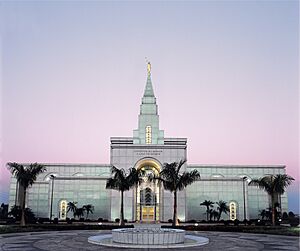
In August 2022, Campinas had a population of 1,139,047 people. Most people (96%) in the city can read. The average life expectancy is about 72 years.
- Human Development Index (HDI): This number shows how well people are doing in terms of health, education, and money. For Campinas, it's 0.805, which is considered "very high".
Who Lives in Campinas?
The people of Campinas come from many different backgrounds. Here's a look at the main groups:
| Color / Race | Percentage |
|---|---|
| White | 59.5% |
| Pardo (Mixed Race) | 30.1% |
| Black | 9.2% |
| Asian | 1.0% |
| Indigenous | 0.1% |
Most of the population (98.28%) lives in the city area. Only a small part (1.72%) lives in rural areas. There are slightly more females (51.78%) than males (48.22%) in Campinas.
Campinas Metropolitan Area
Since 2010, Campinas has been the center of an official metropolitan region (RMC). This area includes 19 other towns. Together, they have about 2.8 million people and cover 3,348 square kilometers (1,293 square miles). This metropolitan area is next to the São Paulo metropolitan region. The Campinas Metropolitan area also has a large economy, with a total value of about R$70.7 billion (around U$42 billion).
Some of the towns in the Campinas Metropolitan Region are:
- Americana
- Artur Nogueira
- Cosmópolis
- Engenheiro Coelho
- Holambra
- Hortolândia
- Indaiatuba
- Itatiba
- Jaguariúna
- Monte Mor
- Nova Odessa
- Paulínia
- Pedreira
- Santa Bárbara d'Oeste
- Santo Antônio de Posse
- Sumaré
- Valinhos
- Vinhedo
Economy of Campinas
Campinas is the richest city in its metropolitan region and the 10th richest city in Brazil. Its economy was worth about 36.68 billion reais in 2010. This means it contributes almost 1% of all Brazil's economic output. Today, Campinas produces 10% of Brazil's industrial goods. It's especially known for high-tech industries and metalworking. Some people even call it the "Silicon Valley of Brazil."
The area around Campinas has 17,677 industries, which is the second-highest number in São Paulo State. There's a large petrochemical area nearby with big companies like DuPont, Chevron, and Royal Dutch Shell.
Campinas has many shopping malls, including Iguatemi Campinas and Shopping Parque Dom Pedro, which is one of the largest in Latin America. The city also has Viracopos International Airport, which is a major airport for cargo (goods) coming in and out of Brazil.
The main economic activities in Campinas are:
- Agriculture: Growing crops like coffee, sugarcane, and cotton.
- Industry: Making things like textiles (cloth), motorcycles, cars, machinery, food, drinks, chemicals, pharmaceuticals (medicines), paper, and electronics.
- Commerce and Services: Shops, restaurants, and other businesses that serve people.
Many national and international high-tech and IT companies have offices in Campinas. These include IBM, Dell, Motorola, Samsung, and Bosch. The airline TRIP Linhas Aéreas is based here, and Viracopos International Airport is a main hub for Azul Airlines.
The automotive industry is also strong, with companies like General Motors, Mercedes-Benz, and Honda. There's also a big pharmaceutical industry with companies like Medley Farma and EMS Farma.
Campinas is home to many research centers and universities. These include the Brazilian Synchrotron Light Laboratory and the Unicamp. Unicamp is one of the best universities in Latin America. The city also has many places for new technology companies to start, called business incubators.
Because of all these high-tech industries and research centers, Campinas is known as the Brazilian Silicon Valley.
Culture in Campinas
The City Department of Culture takes care of Campinas' cultural activities. They plan events and projects to help the city's culture grow.
Campinas has always been a cultural center in São Paulo State. This has grown even more with all the universities. The city has three theaters, a symphony orchestra (one of the best in Brazil), and many music groups. There are also 43 movie screens, many libraries, art galleries, and museums.
Fun Things to Do in Campinas
Campinas has many interesting places to visit:
- Bosque dos Jequitibás: This is a preserved forest area in the city. It reminds visitors of the original rainforest that used to cover the region. It has a small zoo with local animals and a natural history museum.
- The Cathedral: Built in the 19th century, its inside is completely made of beautiful jacaranda wood carvings. It was built using an old technique with clay and rocks, making it one of the largest buildings in the world built this way.
- The Central Market: Here you can find many colorful stalls selling fresh products from the region.
- The Old Central Railway Station: This old train station is now a cultural center.
- Centro de Convivência: This is a cultural area with a theater and an outdoor space for concerts. The Campinas Symphony Orchestra often plays here for free on Sundays.
- The Castelo (Castle) Water Tower: This tower is on the highest point in the city. From its top, you can see a wide view of Campinas.
- The Historical Railway Society of Campinas: This group keeps old steam locomotives and carriages working. They offer fun trips through a scenic area with old coffee farms.
- Lagoa do Taquaral Park: This is a popular park with a lagoon and wooded areas. It has a planetarium, a science museum, a sports stadium, and a swimming pool. You can also find an outdoor concert area, a replica of a caravel ship, and an electric tramway with historic tramcars.
- The Rural Exhibition of Campinas: This is an annual fair that shows off the region's farm products and traditions.
- Birdwatching: The region has many different bird species, attracting people who love to watch birds.
In 2007, readers of the Correio Popular newspaper voted for the "Seven Wonders of Campinas."
Seven Wonders of Campinas
These are the most popular tourist spots in Campinas, chosen by local newspaper readers:
Culture Station
The old train station of Companhia Paulista Railways is a symbol of Campinas' growth. It has been restored and is now a major center for recreation and culture. Many workshops, concerts, and other cultural events happen here all year.
Metropolitan Cathedral
The building of the Cathedral started in 1807 and took over seventy years to finish, opening in 1883. The entire structure was made from pressed clay, an old building method in São Paulo. The inside is decorated with dark jacaranda wood. The four bells in the main tower are over a hundred years old.
Parque Portugal
This park, also known as "Bamboo Grove Lagoon," is great for fun and sports. It has many things to do, like paddleboats and an exact copy of the caravel ship that brought Pedro Álvares Cabral to Brazil. There are also picnic areas, bird nurseries, and fitness equipment. A scenic 4-kilometer (2.5-mile) electric tramway runs through the park, using restored historic tramcars.
Jockey Club Building
Opened in 1925, this building was once the main office for the Jockey Club of Campinas. It has a classic look with an inside design inspired by French palaces from the late 1700s.
Prefecture Ex Market
Located in the center of Campinas, the old Municipal Market, or "Mercadão," opened on April 12, 1908. It was designed by architect Ramos de Azevedo. It's still open today, with colorful stalls full of fresh produce from local farms.
Army Cadets School
This building, in Spanish colonial style, was designed by architect Ernani Do Val Penteado and opened on January 23, 1959. Since 1961, the Escola Preparatória de Cadetes do Exército (Preparatory School of the Brazilian Army) in Campinas has been an important place for training future Brazilian Army officers. Its one-year course helps students prepare for the Academia Militar das Agulhas Negras.
Castle Tower
This water tower was built between 1936 and 1940. It's located on the highest point in the city, 735 meters (2,411 feet) above sea level. From its top, you can enjoy a wide view of the city.
Other Tourist Spots
Other popular places in Campinas include:
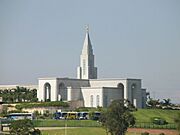
Mormon Temple
|
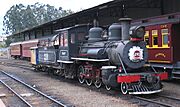
Antique Railway Station
|

Ponte Preta Soccer Stadium
|
|

Carlos Gomes Plaza
|
Sports in Campinas
Campinas is home to two well-known football (soccer) clubs: Associação Atlética Ponte Preta and Guarani Futebol Clube. They play a famous local match called the "Campineiro derby", which has been happening since 1912. There's also Red Bull Brasil, a newer club that has become quite important. Women's football is also growing in the city.
The city has three main sports stadiums:
- Estádio Brinco de Ouro da Princesa: Owned by Guarani, it opened in 1953 and can hold about 29,130 people.
- Sport and Recreation Centre in Campinas Dr. Horacio Antonio da Costa (Cerecamp Stadium): This stadium belongs to the state of São Paulo and opened in 1940.
- Estádio Moisés Lucarelli: Owned by Ponte Preta, it was built by the club's fans. It opened in 1948 and can hold 19,728 visitors. It's often called "Majestoso" (The Majestic One) because it was the third-largest stadium in Brazil when it opened.
Campinas also hosts many other sports events. One is the Corrida Integração (Integration Race), a running event held since 1983. It has a 5 km race for people with disabilities and a 10 km race for others.
The city has a strong history in the Open Games of the Interior, a competition with various sports that started in 1936. Campinas has hosted this competition four times and won it ten times, making it the third city with the most wins.
For tennis, there's the Tennis Club of Campinas (CBT), founded in 1913. It has tennis courts, swimming pools, and courts for basketball and soccer. The Club de Regatas Campineiro and Swim (CCRN) also offers space for many Olympic sports.
City Services
Transportation
Campinas is a big center for transportation and communication in São Paulo State. It's located on major highways that connect the state capital to the northwest and north. The city has a beltway (a road that goes around the city) and several main motorways:
- Rodovia Anhangüera
- Rodovia dos Bandeirantes
- Rodovia Santos Dumont
- Rodovia Dom Pedro I
- Rodovia Adhemar de Barros
- Rodovia Professor Zeferino Vaz
- Rodovia Jornalista Francisco Aguirre Proença
These roads are built to high standards. The Anel Viário José Magalhães Teixeira (SP-038) connects the Anhangüera and Dom Pedro I motorways around the city.
The main airport is Viracopos International Airport. It's about 14 km (9 miles) from downtown Campinas and 99 km (62 miles) from São Paulo city. This airport is the main hub for Azul Brazilian Airlines. In 2022, it served 11.8 million passengers. It also has the second-largest cargo terminal in Brazil. Since 2012, when it became privately managed, the airport has seen many improvements.
A second airport, Campo dos Amarais Airport, is about 8 km (5 miles) from downtown Campinas. It's used for smaller, private planes.
Public Transportation in Campinas
On average, people in Campinas spend about 77 minutes traveling by public transport to and from work on a weekday. About 21% of riders spend more than 2 hours commuting each day. People usually wait about 23 minutes at a bus stop or station. About 52% of riders wait for over 20 minutes daily. The average distance people travel in one public transport trip is 7.9 km (4.9 miles).
Education in Campinas
Portuguese is the official language and the main language taught in schools. However, English and Spanish are also part of the official high school lessons.
Universities and Colleges
Campinas has many universities and colleges, including:
- Unicamp (Universidade Estadual de Campinas);
- IFSP (Instituto Federal de São Paulo);
- INPG Business School;
- PUC-Campinas (Pontifícia Universidade Católica de Campinas);
- UNIP (Universidade Paulista);
- FACAMP (Faculdades de Campinas);
- METROCAMP (Faculdade Integrada Metropolitana de Campinas);
- IPEP (Faculdades Integradas IPEP);
- UNISAL (Centro Universitário Salesiano de São Paulo);
- USF (Universidade São Francisco);
- ESAMC (Escola Superior de Administração, Marketing e Comunicação);
- Universidade Mackenzie;
- FAC (Faculdades Comunitárias de Campinas);
- Faculdades Fleming;
- Faculdade de Odontologia São Leopoldo Mandic.
- Fatec Campinas
Technical Schools
The city also has several technical schools that offer specialized training:
- ETE Bento Quirino (Escola Técnica Estadual Bento Quirino)
- ETEC (Escola Técnica de Campinas)
- ETECAP (Escola Técnica Estadual Conselheiro Antonio Prado)
- POLI Bentinho (Colégio Politécnico Bento Quirino)
- COTUCA (Colégio Técnico da Universidade de Campinas)
- SENAI (Serviço Nacional de Aprendizagem Industrial)
- IFSP (Instituto Federal de São Paulo)
Media in Campinas
Campinas has three daily newspapers, all owned by Rede Anhangüera de Comunicação: Correio Popular, Diário do Povo, and Notícia Já (a smaller newspaper). Many other local newspapers are published weekly or monthly. Several magazines are also published, with Metrópole being the largest.
The city has many radio stations and several local TV stations. Campinas was the first city in Brazil, outside of state capitals, to receive digital TV signals. This started on October 3, 2008, with EPTV, which is part of Rede Globo.
For phone and internet services, the city was served by Companhia Telefônica Brasileira until 1973. Later, it was served by Telecomunicações de São Paulo, which was bought by Telefónica in 1998. Today, the company uses the Vivo brand and provides cell phone, landline, internet, and TV services.
Famous People from Campinas
Many notable people come from Campinas, including:
- Maurício, Olympic Champion volleyball player
- Campos Sales (former president of Brazil)
- Carlos Gomes (opera composer)
- Nelsinho Baptista (footballer)
- Olavo de Carvalho (philosopher and writer)
- Daniel Dias (paralympic swimmer)
- Luciano do Valle (sports commentator)
- Felipe Meligeni Alves (tennis player)
- Marcelo Damy (physicist)
- Gabriel (footballer)
- Gilberto de Nucci (doctor and researcher)
- Renato M.E. Sabbatini (scientist and writer)
- Hércules Florence (inventor)
- Luís Fabiano (footballer)
- Carlos Roberto Martins (businessman)
- Crodowaldo Pavan (biologist and scientist)
- Henrique Martins (World Champion swimmer and Mister Brazil)
- Zeferino Vaz (doctor, former head of UNICAMP)
- Fabiana Murer (pole vaulter)
- Oliver Minatel (footballer)
- José Fiolo (swimmer)
- Sandy (singer)
- Fabinho (footballer)
- Marcel, basketball player
- Ricardo Mello, tennis player
- Fábio Gomes, pole vaulter
Sister Cities
Campinas has "sister city" relationships with many cities around the world. This means they work together on cultural and economic projects.
Here are some of Campinas's sister cities:
 Asunción, Paraguay (1973)
Asunción, Paraguay (1973) Auroville, India (2004)
Auroville, India (2004) Cabinda, Angola (2009)
Cabinda, Angola (2009) Cascais, Portugal (2012)
Cascais, Portugal (2012) Concepción, Chile (1979)
Concepción, Chile (1979) Córdoba, Argentina (1993)
Córdoba, Argentina (1993) Cotorro (Havana), Cuba (2009)
Cotorro (Havana), Cuba (2009) Daloa, Ivory Coast (1982)
Daloa, Ivory Coast (1982) Durban, South Africa (2009)
Durban, South Africa (2009) Fuzhou, China (1996)
Fuzhou, China (1996) Gifu, Japan (1982)
Gifu, Japan (1982) Indianapolis, United States (2009)
Indianapolis, United States (2009) Jericho, Palestine (2003)
Jericho, Palestine (2003) Malito, Italy (2006)
Malito, Italy (2006) San Diego, United States (1995)
San Diego, United States (1995) Viseu, Portugal (2012)
Viseu, Portugal (2012) Zaragoza, Spain (2013)
Zaragoza, Spain (2013)
Campinas also has cooperation agreements with other cities, like Fundão, Portugal. It also cooperates with cities within Brazil, such as Belém, Blumenau, and Ubatuba.
Images for kids
See also
 In Spanish: Campinas para niños
In Spanish: Campinas para niños


